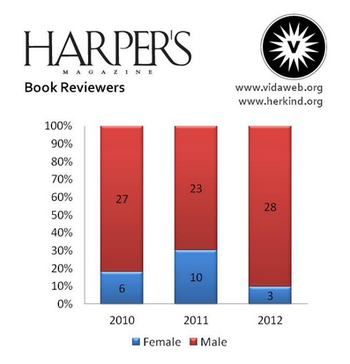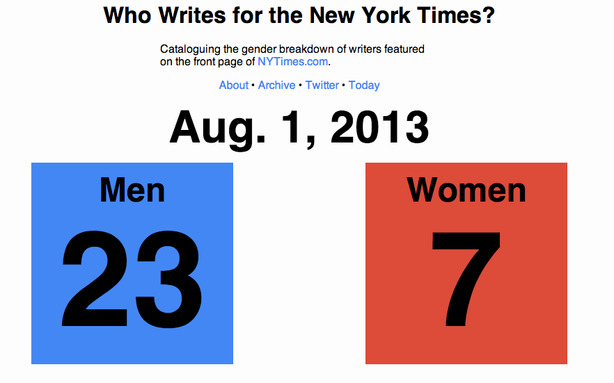What Women Want: Bylines
If you looked at the homepage of The New York Times' website right this second, you could count up and find that 24 men and 8 women have bylines. Or you could go to WhoWritesFor, which culls data every five minutes to show the gender disparity on the front web page of a paper that in total gets 29 million visitors per month.
RELATED: Is It Okay for Rich People to Spend Oodles on Kids' Playhouses?
Andrew Briggs, a recent Northwestern grad, built the site and launched it this week. "It's not like the talent isn't there," he told The Atlantic Wire in an email. "I don't for a minute think that the Times sets out to feature two or three times as many men as women, it's just the kind of thing that happens if people aren't thinking about it."
RELATED: How to Report on Mexican Cartels and Live to Tell
He doesn't consider himself an activist, however: "I wanted to make sure from day one that the information would speak for itself."
RELATED: Guantanamo Prisoner Takes Hunger Strike to New York Times Op-Ed Page
VIDA, an organization for women in the literary arts, has been doing a similar analysis of gender disparity in top media outlets since 2010. Each year, VIDA publishes "The Count," which shows how many men and how many women are writing for prestigious publications like Harper's, The Paris Review, and The New York Times Book Review. They've consistently found that (many) more men get the coveted bylines. So is anything changing?
RELATED: Bob Herbert Leaving The New York Times Op-Ed Page
VIDA co-founder Erin Belieu told The Atlantic Wire in an email:
These initiatives have been helpful and will be even more helpful in the long run. Like all civil rights issues, raising people's awareness around these issues is the first necessary step to change. And it appears, from all the conversation VIDA has started both in the literary and journalism worlds, our community's consciousness is actively and energetically being raised.
Belieu also wrote that she was pleased WhoWritesFor took inspiration from The Count, "down to the color graphic." Both use a combination of red and blue to signify the different genders.
RELATED: Goldman Sachs Mulling Layoffs, Smaller Drinking Cups
As far as enacting any concrete change, some have suggested that getting women's byline count up comes down to leadership. Belieu noted that Pamela Paul, the new editor of The New York Times Book Review, vowed to address gender bias within her publication at a panel the two were on together.
Both Briggs and Belieu think gender imbalance on the front page of The Times and in other prestigious publications has a lot to do with attitude. "I really have no idea where the imbalance comes from, except maybe from this kind of stodgy old guard of capital-J Journalism that's made up of a bunch of dudes who resist change," Briggs wrote.
Belieu echoed that sentiment: "There are some dinosaurs who want to act like none of this is happening. But then, you know what happened to the dinosaurs."


